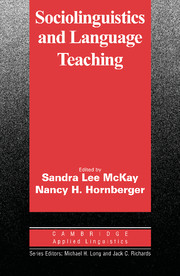Part II - LANGUAGE AND VARIATION
Published online by Cambridge University Press: 22 July 2009
Summary
The chapters in this part, which focus on how the larger social context affects an individual's use of particular linguistic forms, illustrate a macrolevel of social analysis and a microlevel of linguistic analysis. The authors of Part II demonstrate how geographical location, ethnic background, social class, and gender can all influence an individual's use of particular phonological, structural, lexical, and discourse features of English. At the same time, the chapters illustrate how these linguistic features can serve to define speech communities and perpetuate existing social relationships. Taken together, the next three chapters exemplify the tremendous variation that can exist in the use of English in Anglophone countries.
In Chapter 5, John Rickford examines how geographical region, social class, and ethnic background can affect the linguistic features an individual uses. To begin, Rickford discusses typical methods for studying regional variation and points out the reasons for the development of regional dialects, including geography, settlement patterns, and migration routes. He goes on to define such terms as dialect areas, isoglosses, and relic areas. This discussion is followed by an examination of language variation due to age and social class and network in which Rickford introduces such concepts as age grading, the principle of accountability, and sociolinguistic markers and indicators. Finally, he discusses the manner in which race and ethnicity can influence language use and summarizes the major phonological and grammatical features of African-American Vernacular English.
- Type
- Chapter
- Information
- Sociolinguistics and Language Teaching , pp. 149 - 150Publisher: Cambridge University PressPrint publication year: 1995

